#virtual reality applications development
Explore tagged Tumblr posts
Text
The Ultimate Guide to Virtual Reality Software for Architecture

In the ever-evolving world of architecture, staying at the forefront of technology is paramount. One such technological advancement that has revolutionized the architectural industry is virtual reality (VR). Virtual reality architecture software has ushered in a new era of design, presentation, and client engagement. In this comprehensive guide, we'll explore the world of virtual reality architecture software, its benefits, and a spotlight on ProtoTech Solutions as a leading player in the field.
Understanding Virtual Reality Architecture Software
Virtual Reality (VR) is a technology that immerses users in a computer-generated environment, allowing them to interact with and navigate through it as if it were real. In architecture, VR software leverages this technology to create immersive 3D environments of architectural designs and spaces.
Key Features of Virtual Reality Architecture Software
1. Immersive Visualization: VR software provides architects, designers, and clients the ability to walk through a building or space as if they were physically present. This immersive experience enhances design comprehension.
2. Real-time Collaboration: Many VR architecture tools offer real-time collaboration features, allowing multiple stakeholders to review and make decisions on designs simultaneously, no matter where they are located.
3. Design Iteration: VR software enables architects to make real-time changes to designs, which can be immediately visualized, facilitating rapid design iteration and decision-making.
4. Client Engagement: Using VR during client presentations is a powerful way to convey design concepts, helping clients understand and feel the space before it's built.
5. Data Integration: Some VR solutions integrate with Building Information Modeling (BIM) software, enabling architects to import 3D models and data for a seamless design-to-VR workflow.
Benefits of Using Virtual Reality Architecture Software
1. Enhanced Design Communication
VR software bridges the gap between architectural drawings and the client's understanding of the design. Clients can "walk" through the virtual space, gaining a comprehensive understanding of the project, reducing miscommunication, and enhancing the decision-making process.
2. Streamlined Design Review
Design teams and clients can collaborate in real-time within the virtual environment, making changes and annotations directly in the 3D model. This streamlines the design review process and ensures everyone is on the same page.
3. Reduced Costs
By identifying design flaws and issues early in the process, VR architecture software can help avoid costly revisions during construction. It also allows for better design optimization, potentially reducing construction costs.
4. Competitive Advantage
Architectural firms that adopt VR technology gain a competitive edge by showcasing their projects in immersive, engaging ways. It can impress clients and help secure new projects.
Spotlight on ProtoTech Solutions
ProtoTech Solutions is a renowned name in the world of virtual reality architecture software. As a leader in this field, ProtoTech Solutions offers a range of innovative solutions tailored to the needs of architects and designers.
ProtoTech's Virtual Reality Software Features
1. Immersive VR Experiences: ProtoTech's VR solutions provide highly immersive experiences, making it easy for clients and stakeholders to visualize architectural designs.
2. Cross-Platform Compatibility: ProtoTech offers VR solutions that work seamlessly across multiple platforms and devices, including VR headsets, desktops, and mobile devices.
3. BIM Integration: ProtoTech's VR software can integrate with popular BIM tools, enabling architects to import complex 3D models and data effortlessly.
4. Real-time Collaboration: ProtoTech's collaboration features allow architects and clients to review and modify designs in real-time, improving communication and decision-making.
Why Choose ProtoTech Solutions?
Expertise: ProtoTech Solutions has a team of skilled professionals with extensive experience in VR development and architecture.
Customization: They offer tailored solutions to match the unique needs of architectural firms and construction companies.
Proven Track Record: ProtoTech has a strong track record of delivering high-quality VR solutions for the architecture industry.
Support and Training: ProtoTech provides comprehensive support and training to ensure users can maximize the benefits of their VR software.
In conclusion,
virtual reality architecture software has redefined the way architects design, collaborate, and present their projects. With ProtoTech Solutions at the forefront of this technological revolution, architects and designers have a trusted partner to help them unlock the full potential of VR in their work. Embrace the power of virtual reality and stay ahead in the world of architecture.
#virtual reality software for architecture#ar vr app development#ar vr app development services#ar vr development services#3d virtual reality software#virtual reality app development#virtual reality applications development#vr app development services#vr software for architecture#virtual reality project management#virtual reality software architecture#vr application services#augmented reality software architecture#virtual reality architecture software#augmented reality android development
0 notes
Text
Immersive Learning: The Power of VR in Training - Atcuality
At Atcuality, we believe that learning should be as dynamic as the challenges you face. That’s why our VR-based training solutions are transforming how individuals and teams acquire new skills. With VR, we simulate real-life environments, enabling learners to practice, adapt, and succeed without the consequences of real-world mistakes. Our solutions are cost-effective, scalable, and highly engaging, making them ideal for industries like healthcare, construction, and corporate training. Experience the unmatched advantages of immersive technology and give your team the tools they need to excel. Step into the future of education with Atcuality.
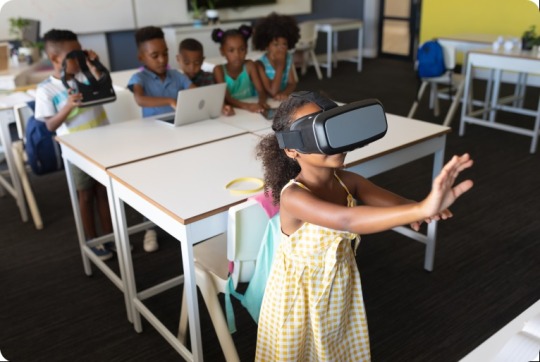
#seo services#seo marketing#artificial intelligence#seo company#seo agency#ai powered application#digital marketing#azure cloud services#iot applications#amazon web services#augmented human c4 621#augmented reality agency#augmented and virtual reality market#augmented intelligence#augmented reality#ai applications#ai app development#ai generated#technology#virtual reality#digital services#web development#web design#web developers#web developing company#website development#cash collection application#blockchain#metaverse#wordpress
2 notes
·
View notes
Text
#theintellify#mobile application development#web application development#cloud consulting services#augmented reality#virtual reality#ar vr technology#arvr#ar vr development company#ar vr development services
2 notes
·
View notes
Text
In recent years, Virtual Reality (VR) and Augmented Reality (AR) have made significant strides in transforming industries, education, entertainment, and even healthcare. While both technologies are often grouped under the term extended reality (XR), they represent distinctly different experiences. This detailed comparison will explore both VR and AR in terms of their definitions, differences, applications, advantages, challenges, and potential future directions.
#Virtual Reality (VR)#Augmented Reality (AR)#Extended Reality (XR)#VR technology#AR applications#VR vs AR#Immersive experiences#AR devices#VR gaming#AR in retail#VR training simulations#AR navigation#VR headsets#AR education#Mixed Reality (MR)#VR healthcare applications#AR in marketing#AR glasses#VR development#Future of VR and AR
0 notes
Text

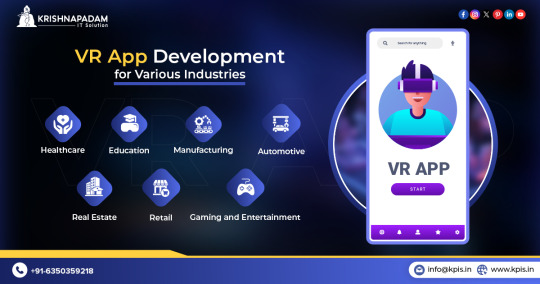
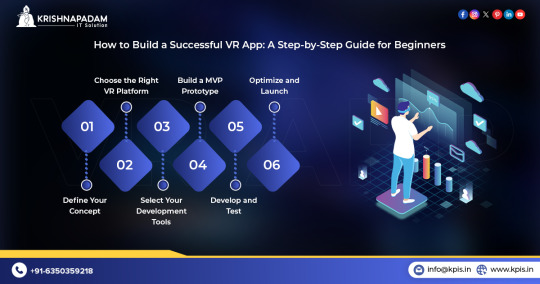


Whether you’re a beginner or an experienced developer, understanding the evolving landscape of VR technology will be crucial in crafting successful, engaging VR applications in 2025 and beyond. At KPIS, our team of experienced VR app developers and analysts integrate VR technology into your business after closely analyzing your industry, competitors, and target audience.
Have queries or want to know more about our virtual reality app development services or Trending Trends and Technologies of Virtual Reality (VR) App Development in 2025? Partner with us to bring your brand’s interactions to life and enjoy incredible success in the digital space.
#VR#virtual reality#VRMobileApp#VRApp#AppDevelopment#web development#app development#game development company#technology#internet of things#artificial intelligence#game development#application development#Hire App Developers#Software Development
0 notes
Text
Revolutionize your remote home inspections by using internet of things (IoT), augmented reality (AR), and virtual reality (VR) to provide a superior home inspection experience.
#IoT#AR#VR#internet of things#augmented reality#virtual reality#Remote Home Inspections#Home Inspections#Home Inspection Software#Home Inspection Software Development#Mobile Application Development#Software Development
0 notes
Text
Envisioning the Horizon of Mobile Application Evolution: Forecasts and Paradigms to Anticipate
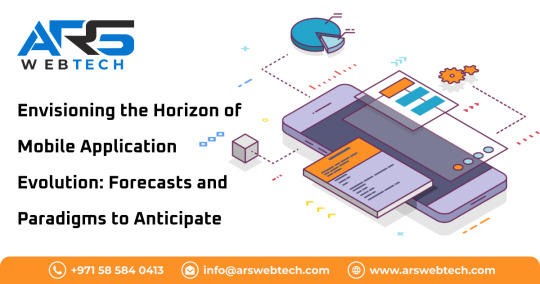
By 2027, the globe will witness a congregation of 7.6 billion mobile telephony subscribers, heralding an era of exponential expansion in the app domain. This upsurge transcends mere numerical augmentation, signifying a fertile landscape ripe for innovative explorations and ventures.
The vectors poised to sculpt the mobile app constellation in the UAE, as envisioned by ARS Webtech, are multifaceted. The aftermath of the Covid-19 pandemic, the dawn of 5G connectivity, and an escalating quest for convenience will collectively steer this voyage. This transition is not an abrupt revelation but a foreseen evolution, driven by burgeoning trends and technological advancements, all in pursuit of enhanced velocity, pertinence, and interconnectedness in app genesis.
An elucidation by eMarketer projects the ascendancy of proximity mobile payment aficionados in the U.S. to touch the 101.2 million mark by 2022.
Programming Ecosystems and Linguistic Evolutions: A Metamorphosis
The panorama of programming languages and developmental methodologies is on the cusp of a radical transformation. Developers are anticipated to encounter a paradigmatic shift in application fabrication strategies, necessitated by the complex nature of modern mobile applications. This demands an ingenious blend of creativity and strategic foresight, with developers recalibrating their methodologies to embrace user-centricity, scalability, and efficiency, heralded by ARS Webtech.
Harnessing Artificial Intellect for Tailored Experiences
The trajectory of personalization in mobile apps and web design within Dubai is being redefined by Artificial Intelligence (AI), including its subsets of Machine Learning and Deep Learning. This avant-garde domain enables algorithms to evolve, enhancing their proficiency in emulating human comportment. AI emerges as a versatile instrument for developers aiming to elevate their applications, from integrating seamless voice recognition to delivering customized content with precision.
Embedding Blockchain in Mobile Ecosystems
The incorporation of Blockchain technology transcends the conventional boundaries of mobile applications, often associated solely with cryptocurrencies. Its underpinning framework of smart contracts offers a lucid and secure milieu for predetermined app-related compacts, instigating a novel paradigm characterized by decentralized operations, heightened security, and transparency.
The global mobile payment transaction value is anticipated to burgeon to $6.6 trillion by 2021, as per Statista, signaling a robust adoption trajectory.
Internet of Things: Enabling Connected Existences
The fusion of cloud technology and the Internet of Things (IoT) is set to revolutionize mobile app creation and web design in Dubai, propelling forward with wireless networked devices. This connectivity extends beyond mere wearables, encapsulating a broad spectrum of devices that augment convenience and quality of life.
"The melding of augmented and virtual realities represents not merely a technological leap but a portal into a novel realm of user engagement, transforming our digital content interactions," remarks Tech Visionary, Dr. Emily Rodriguez.
The Rise of Mobile Wallets
The advent of mobile wallets has irrevocably altered the payment landscape, enhancing user convenience and revolutionizing transaction methodologies. With technological advancements, mobile wallets are poised for further evolution, incorporating advanced security measures, simplifying transactions, and ensuring seamless integration across diverse digital platforms, aiming for a cohesive, secure, and user-friendly payment experience.
A Deloitte survey indicates that 88% of mid-market enterprises are either exploring or adopting AR and VR technologies for commercial applications.
Augmented & Virtual Realities: Crafting Immersive Realms
Augmented Reality (AR) and Virtual Reality (VR) are set to redefine engagement with digital content, offering immersive experiences within the metaverse. These technologies are finding their place across various sectors, facilitating virtual solutions that transcend physical limitations, like sports simulations and virtual property showcases.
Adopting Declarative Coding for Fluid Animations
The shift towards declarative syntax, exemplified by React Native and SwiftUI, marks a significant stride in enhancing mobile app aesthetics. This approach simplifies the incorporation of complex animations, enabling developers to craft and manage intricate visual elements more efficiently, thus streamlining the development process and offering users engaging and fluid animations that enrich the app's overall ambiance.
The AR and VR market is projected to expand to $72.8 billion by 2024, according to a report.
Chatbot Integration
With advancements in neural language processing, chatbots are becoming pivotal in mobile app development in Dubai. These AI-driven assistants, evolving to mimic human interactions more closely, are refining customer support by providing efficient and personalized engagement. Businesses integrating chatbots into their apps and web designs in Dubai are enabling users to enjoy seamless interactions, prompt query resolutions, and engaging conversational exchanges.
Beacon Technology for Location-centric Apps
Beacon technology is enhancing customer engagement in physical retail spaces through highly targeted and location-specific applications. By leveraging beacon signals, these apps and web designs in Dubai can deliver customized content, augment the relevance of retail communications, and enhance loyalty programs, allowing direct and contextual interaction with consumers and elevating the in-store experience.
"The surge of mobile wallets is transforming consumer financial interactions, presenting a streamlined and secure payment interface that resonates with our digital era's demands," financial analyst Sarah Thompson observes.
ARS Webtech: Sculpting the Mobile App Development Future
In the dynamically shifting terrain of mobile app development and web design in Dubai, ARS Webtech emerges as a vanguard, championing innovative solutions and cutting-edge technology. As we delve into the predictions and trends molding the mobile app development future, ARS Webtech stands at the vanguard, poised to navigate and adapt to the industry's fluid dynamics.
In conclusion, the journey of mobile app development is poised to be a thrilling adventure, fueled by creativity, the integration of state-of-the-art technologies, and a relentless quest for user-centric solutions. The mobile app landscape, as shaped by ARS Webtech, will continue to evolve, presenting users with novel experiences and opportunities.
#App Development Company in Dubai#Mobile Application Development Company#Mobile App Development Company Dubai#Mobile App Development Company Abu Dhabi#Mobile App Development Company UAE#Mobile App Development Services#Mobile App Development Sharjah#Custom App Development Company in Dubai#IOS App Development Company In Dubai#augmented reality#virtual reality
0 notes
Text
Exploring the Boundaries: The Latest in Augmented Reality Software
Augmented and Virtual Reality (AR VR) Software
Explore the transformative potential of augmented and virtual reality (AR VR) software in this comprehensive article. Discover its evolution, applications, advantages, challenges, and future trends.
Augmented and virtual reality (AR VR) software has transformed the way we perceive and interact with digital environments. As technology continues to evolve, the boundaries between the physical and digital worlds blur, offering unprecedented experiences and opportunities. In this article, we delve into the realm of AR VR software, exploring its evolution, applications, advantages, challenges, and future prospects.
Introduction to Augmented and Virtual Reality (AR VR) Software
Augmented reality (AR) and virtual reality (VR) are immersive technologies that overlay digital content onto the real world or create entirely simulated environments, respectively. While AR enhances the existing environment by adding digital elements, VR immerses users in a completely virtual setting. AR VR software serves as the backbone of these experiences, enabling developers to create compelling content and applications.
Evolution of AR VR Software
The roots of AR VR technology trace back to the early experiments in computer graphics and simulation. Over the decades, advancements in hardware capabilities, display technologies, and computing power have propelled AR VR software to new heights. From bulky headsets to sleek, lightweight devices, the evolution of AR VR hardware has revolutionized user experiences and accessibility.
Key Features and Components
AR VR software encompasses a range of features and components, including immersive 3D graphics, spatial tracking, gesture recognition, and real-time rendering. These elements work in tandem to create seamless and interactive experiences for users across various platforms and devices.
Applications across Industries
The versatility of AR VR software extends across diverse industries, including healthcare, education, gaming, architecture, automotive, and entertainment. From medical simulations and virtual classrooms to interactive gaming experiences and architectural visualization, AR VR technology is reshaping how we work, learn, and play.
Advantages of AR VR Software
One of the primary advantages of AR VR software is its ability to create immersive and engaging environments that captivate users' attention. Whether used for training simulations, virtual tours, or interactive storytelling, AR VR experiences enhance user engagement, retention, and comprehension.
Challenges and Limitations
Despite its potential, AR VR software faces several challenges, including technical constraints, content creation complexities, and user adoption barriers. Additionally, the cost of hardware and development can pose significant challenges for organizations seeking to integrate AR VR into their workflows.
Future Trends in AR VR Software
Looking ahead, the future of AR VR software is filled with promise and innovation. From advancements in wearable technology and haptic feedback to the integration of AI and machine learning, the next generation of AR VR experiences will be more immersive, intuitive, and adaptive.
Case Studies
Several organizations have already embraced AR VR technology to create impactful experiences and drive business outcomes. From IKEA's virtual furniture showroom to medical training simulations by surgical institutes, these case studies highlight the transformative power of AR VR software across various sectors.
How to Choose the Right AR VR Software
Selecting the right AR VR software requires careful consideration of factors such as compatibility, functionality, scalability, and support services. Whether developing custom applications or leveraging existing platforms, organizations must align their objectives with the capabilities of the chosen software.
Developing AR VR Software
Developers have access to a plethora of tools, frameworks, and platforms for creating AR VR experiences. From Unity and Unreal Engine to proprietary SDKs and APIs, the development landscape offers flexibility and scalability for projects of all sizes and complexities.
Integrating AR VR into Business Strategies
Businesses can leverage AR VR technology to enhance customer engagement, streamline operations, and differentiate their brand in competitive markets. By incorporating AR VR into marketing campaigns, product demonstrations, and training programs, organizations can create memorable experiences that resonate with their target audience.
Ethical Considerations in AR VR Development
As AR VR technology becomes more pervasive, ethical considerations surrounding privacy, data security, and content moderation come to the forefront. Developers and organizations must prioritize user safety and transparency while adhering to industry regulations and ethical guidelines.
The Role of AI in Augmented and Virtual Reality
Artificial intelligence (AI) plays a pivotal role in advancing AR VR technology, enabling personalized experiences, intelligent content recommendations, and predictive analytics. By harnessing the power of AI, AR VR software can adapt to user behaviors, preferences, and contextual cues, enhancing immersion and interactivity.
Education and Training in AR VR
Educators and trainers are increasingly turning to AR VR technology to create immersive learning experiences that transcend traditional boundaries. From virtual field trips and historical reconstructions to hands-on simulations and skill-based training, AR VR offers endless possibilities for education and training.
Conclusion
In conclusion, augmented and virtual reality (AR VR) software represents a paradigm shift in how we interact with digital content and environments. With its ability to create immersive experiences across various industries and applications, AR VR technology holds immense potential for innovation, exploration, and human connection. As we navigate the complexities and possibilities of this transformative technology, it is essential to remain ethical, inclusive, and mindful of the impact on society.
FAQs
What distinguishes augmented reality from virtual reality?
How does AR VR software enhance user engagement?
What are some challenges associated with developing AR VR applications?
Can AI enhance the capabilities of AR VR software?
How is AR VR technology being used in education and training?
#Augmented reality software#Virtual reality development#AR VR technology trends#Immersive experiences#AR VR applications in education#Virtual reality gaming#AR VR hardware#Interactive storytelling#Augmented reality in healthcare
0 notes
Text
Top 9 Ideas in the Travel App Development - Technology Org
New Post has been published on https://thedigitalinsider.com/top-9-ideas-in-the-travel-app-development-technology-org/
Top 9 Ideas in the Travel App Development - Technology Org
The future of travel is bright, and 2024 is going to be an exciting year for travel tech. People are going to want apps that make travel planning and experiences seamless, social, and sustainable. Forget about generic review and booking apps — those are so 2020. The travel apps of the future need to be powered by AI, leverage AR and VR, focus on unique experiences, and bring travelers together around shared interests.
A traveler using his smartphone. Image credit: Clem Onojeghuo via Unsplash, free license
Innovative Features Travelers Want in 2024
In 2024, travel application development needs to provide innovative features to meet the needs of travelers in a post-pandemic world. Some features we can expect to see include:
Personalized Itineraries
Incorporating user learning features into travel apps is becoming a key aspect of app development. These apps look at things the user likes, such as places they have searched for, spots they have saved, and reviews they have written. Using this information, the apps understand what kind of trips the user prefers. Then, they suggest travel plans made just for that person. These could be short plans or longer trips with many stops. The main aim of these customized plans is to make planning trips easy and to help make the user’s vacation special and memorable.
Touchless Check-In
Travel apps are starting to introduce contact-free check-ins as an emerging trend. Travelers are increasingly able to check into hotels, rental cars, flights, and events using their phones, avoiding any physical contact. By utilizing QR codes, Bluetooth, and location services, these apps verify the traveler’s identity and allow access to rooms or cars. This trend is making check-ins not only easier but also cleaner and safer, bringing added comfort to the travel experience.
Health and Safety Alerts
Travel apps are now designed to keep users informed with the latest health and safety news that could impact their trips. They can send alerts about major issues such as natural disasters, disease outbreaks, travel warnings, public transport issues, or nearby crimes. This helps users stay prepared and safe. These updates focus on reducing risks and providing important information about the user’s destination, aiming to make travel smoother and free from worries.
Multilingual Support
It’s becoming the norm for travel apps to provide options in multiple languages, including Spanish, French, German, Chinese, Hindi, and Arabic. This means that people can use the app in the language they are most comfortable with. The goal of this feature is to make travel apps accessible to more people worldwide, ensuring that everyone can use them easily, regardless of their language. With these new features, travel apps are preparing to assist a diverse range of travelers on their journeys.
Key Design and Functionality Considerations for Travel Apps
For a travel app development to keep up with the times in 2024, certain key design and functionality considerations will be crucial. Let’s take a look at the main ones:
Personalization
Many travelers want their trips to fit what they like and are interested in. This means they should be able to choose the kind of places they want to visit, the activities they enjoy, the food they want to try, and even the weather they prefer. After making these choices, the service changes its recommendations and search results to match. Using AI and machine learning can make the service even better at giving useful suggestions as time goes on.
Integrated Planning Tools
Being able to plan an entire trip with just one travel app can be really helpful for travelers. This could include ways to book flights, rent cars, plan tours and activities, make restaurant reservations, and find places to stay like hotels or rentals. Also, having a place in the app where users can keep all their trip details, like itineraries, travel documents, tickets, and other important info, would be very useful.
AR and VR Features
Augmented and virtual reality are changing the way we use travel apps. Imagine taking virtual tours of places, hotels, and interesting spots before you even get there. Augmented reality can show travelers details about different places, buildings, or natural spots while they’re exploring. These features are making travel apps really important for planning trips and enjoying them while on the go.
Real-Time Information
Travelers can get a lot out of up-to-date information. The app can help by giving tips based on things like traffic, how busy places are, the weather, and events happening around. It can also let travelers know if there are any changes to their plans, like flight delays, and suggest other options. This includes updates on their flight, gate changes, and where to pick up their bags.
Social Integration
The app can also help travelers connect with each other. They can share their reviews, favorite places, photos, trip plans, and stories. This way, people with similar interests or who have visited the same places can meet. Having this social part in the app creates a community feel, making people want to come back and chat with other travelers.
Conclusion
The future of travel is looking to make journeys smoother and more effortless for everyone. With the use of augmented reality, intelligent suggestions from AI, and easy booking and payment processes, traveling is set to become a more personalized experience. The leading travel apps will use these advanced technologies to plan a customized trip from beginning to end, tailored to each individual’s interests and budget.
#2024#ai#alerts#app#app development#application development#apps#ar#Augmented and virtual reality#augmented reality#bluetooth#book#buildings#Cars#Community#Design#details#development#Disease#easy#Events#Features#flight#Food#Future#GATE#Giving#Health#how#Ideas
1 note
·
View note
Text
Amazing Fusion of Virtual Reality in Entertainment 2024
Devstree Australia unveils a groundbreaking fusion of entertainment and virtual reality in 2024. Elevating immersive experiences, the company seamlessly blends cutting-edge VR technology with entertainment, creating a new era of captivating and interactive content. Devstree Australia is at the forefront, reshaping how we engage with entertainment through unparalleled virtual reality innovations.
#australia#devstreeau#mobileappdevelopment#iphone#mobile app developer company#ios#web app development#mobile app company#iot app development#iot applications#game development services#Virtual Reality
0 notes
Text
6 Game-Changing BIM Trends in 2023

Introduction
In the ever-evolving landscape of the Architecture, Engineering, and Construction (AEC) industry, Building Information Modeling (BIM) continues to play a pivotal role in transforming the way projects are planned, designed, constructed, and managed. As we step into 2023, it's crucial to explore the emerging trends that are set to reshape the AEC sector and push the boundaries of BIM technology. In this blog post, we delve into the in-depth analysis of the BIM trends that are expected to define the industry in 2023.
1. Cloud-Based BIM Collaboration:
One of the most significant trends in 2023 is the increasing adoption of cloud-based BIM collaboration. Cloud technology allows stakeholders to access and collaborate on a centralized BIM model from anywhere in the world, fostering real-time collaboration and improving project efficiency. This trend is driven by the need for seamless communication among project teams, including architects, engineers, contractors, and facility managers.
2. AI and Machine Learning Integration:
The integration of Artificial Intelligence (AI) and Machine Learning (ML) into BIM processes is gaining momentum. In 2023, we can expect to see advanced AI algorithms being used to analyze massive datasets generated by BIM models. This will enable more accurate predictions regarding project timelines, cost estimates, and even potential risks. Machine learning algorithms can also enhance design optimization and automate routine tasks, allowing professionals to focus on more complex and creative aspects of their work.
3. Generative Design and Parametric Modeling:
Generative design, coupled with parametric modeling, is poised to revolutionize the design phase of construction projects. By leveraging algorithms to explore countless design iterations based on predefined parameters, architects and engineers can generate innovative and optimized solutions. This trend not only accelerates the design process but also results in more sustainable and cost-effective structures.
4. Digital Twins for Lifecycle Management:
Digital Twins, virtual replicas of physical assets or systems, are becoming an integral part of BIM workflows. In 2023, we anticipate an increased focus on using Digital Twins for lifecycle management of buildings and infrastructure. From construction to operation and maintenance, Digital Twins provide a holistic view of a project, enabling better decision-making, predictive maintenance, and improved overall performance.
5. Augmented Reality (AR) and Virtual Reality (VR) in BIM:
The convergence of BIM with Augmented Reality (AR) and Virtual Reality (VR) is set to enhance the visualization and communication of construction projects. Stakeholders can experience virtual walkthroughs of a building before it's constructed, identify potential issues, and make informed decisions. This immersive experience not only improves collaboration but also aids in client presentations and stakeholder engagement.
6. Blockchain for Data Security and Collaboration:
As BIM involves the sharing and collaboration of sensitive project data, ensuring its security and integrity is paramount. Blockchain technology is emerging as a solution to address these concerns. In 2023, we expect to see increased adoption of blockchain in BIM processes, providing a decentralized and secure platform for data exchange, version control, and audit trails.
Conclusion
The AEC industry is standing on the precipice of a BIM revolution in 2023. The trends outlined above showcase the industry's commitment to leveraging cutting-edge technologies to enhance collaboration, efficiency, and innovation throughout the project lifecycle. As professionals embrace these trends, they will not only stay competitive in the market but also contribute to the evolution of a more sustainable and technologically advanced AEC sector. Embracing these trends is not just a choice but a necessity for those looking to shape the future of the industry.
At ProtoTech Solutions, Elevate your project management and design processes with customized BIM Application Development Services. From conceptualization to implementation, we craft solutions that seamlessly integrate into your existing systems, providing the AEC industry with the tools needed to excel in a dynamic and competitive landscape.
#BIM Trends in 2023#BIM Trends#AEC Industry#Cloud-Based BIM Collaboration#AI and Machine Learning Integration#Digital Twins#Augmented Reality#Virtual Reality#Blockchain#BIM Application Development
0 notes
Text
Create Impactful Digital Experiences with Augmented Reality Development Services
At Atcuality, we believe in the power of augmented reality to transform how users interact with brands. Our augmented reality development services provide businesses with innovative solutions that captivate audiences by blending digital and real-world elements. This immersive technology enables users to visualize products, explore environments, and experience services in a whole new way. Our experienced team of developers and designers work collaboratively with clients to deliver custom AR applications that align with specific business goals. By adopting AR, businesses can enhance customer engagement, increase interaction, and differentiate themselves in a crowded market. With Atcuality’s augmented reality development services, you can create digital experiences that leave a lasting impression, building stronger connections with your audience. Discover how AR can benefit your brand and redefine customer interaction with Atcuality's expertise at your service.
#iot applications#artificial intelligence#technology#digital marketing#seo marketing#seo#seo services#emailmarketing#search engine optimization#google ads#socialmediamarketing#augmented reality#augmented human c4 621#augmented and virtual reality market#blockchain#ai powered application#amazon web services#mobile app development company#mobile app developers#mobile application development#app developers#app development company#azure cloud services#cash collection application#cloud security services#iot app development services#task management solution
3 notes
·
View notes
Text
Navigating the Metaverse: A Beginner's Guide
What Is the Metaverse?
The metaverse is a digital universe blending virtual reality (VR), augmented reality (AR), and blockchain technology, allowing users to interact in immersive, 3D environments. It’s a place where the physical and digital worlds merge, offering new opportunities for social interactions, commerce, and entertainment.
Key Technologies in the Metaverse
1. Virtual Reality (VR)
VR enables users to fully immerse themselves in digital environments using headsets and controllers.
2. Augmented Reality (AR)
AR overlays digital elements on the real world, enhancing physical surroundings with interactive layers.
3. Blockchain and Cryptocurrency
Blockchain ensures secure transactions, while cryptocurrencies like Ethereum and Bitcoin drive the metaverse economy.
4. NFTs (Non-Fungible Tokens)
NFTs are unique digital assets used to buy, sell, and trade virtual goods, such as artwork or property, ensuring secure ownership in the metaverse.
Accessing the Metaverse
To explore the metaverse, users need a VR headset, a stable internet connection, and access to platforms like Decentraland, The Sandbox, or Horizon Worlds.
Avatars in the Metaverse
Avatars are digital representations that users create to explore and interact within the metaverse. These customizable avatars serve as your identity in virtual worlds.
Popular Metaverse Platforms
Decentraland: A blockchain-based platform where users own virtual land.
The Sandbox: A digital world enabling users to create and monetize virtual spaces.
Horizon Worlds: Meta's platform focused on social experiences through VR.
Future Applications
The metaverse is reshaping industries, from socializing and gaming to business, education, and commerce. However, challenges like data privacy, digital inequality, and regulation remain critical issues.
#theintellify#ar vr technology#augmented reality#virtual reality#mobile app development#software development#web application development#technology
0 notes
Text
Globally, the fields of augmented reality (AR) and virtual reality (VR) have experienced explosive growth, with India emerging as a major participant in this technological revolution. The need for augmented reality (AR) and virtual reality (VR) solutions is rising quickly as businesses all over the nation become aware of these technologies' revolutionary potential. At the vanguard of this shift are businesses like Simulanis Solutions, who are advancing innovation and offering cutting-edge AR and VR services to a range of industries.
#AR and VR Companies in India#Augmented Reality Solutions India#Virtual Reality Companies India#AR/VR Development India#AR/VR Solutions Provider India#AR and VR Technologies India#AR and VR Application Development India#AR and VR Training Solutions India#Immersive Technologies India#AR/VR for Business India#AR and VR Startups India#Custom AR and VR Solutions India#AR/VR for Healthcare India#AR/VR for Education India#Virtual Reality Experiences India#AR and VR Game Development India#AR/VR in Retail India#Enterprise AR/VR Solutions India#AR and VR Marketing India#Interactive AR/VR Experiences India
0 notes
Text
Do you want to present simulated environments for your users within a defined budget? Or learn more about the trends and technologies of virtual reality (VR) app development in 2025. If yes, then you on the right place. KPIS Pvt. Ltd. is the leading Virtual Reality (VR) app development company in India, to help your business with future-ready success with our customized solutions. Our team of VR app developers always integrates their expertise and hands-on experience for customized solutions. So, that you get market-focussed and best-in-class mobile and web applications. Moreover, we present customized VR development services that meet your business needs and customize solutions.
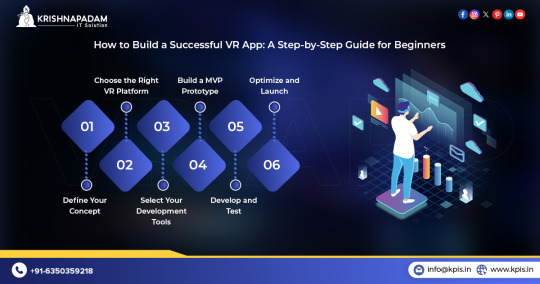
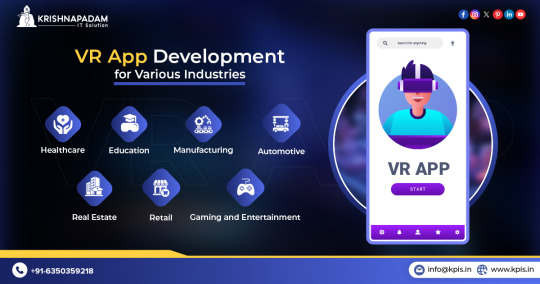

#VR#VR App#VR App Development Company#virtual reality#app development#web development#application development#game development company#technology#artificial intelligence#internet of things#game development#rummy game development#iot#VR Services#VR Development#vr games#vr headset#vr chat#AR VR App
0 notes
Text
Trends And Opportunities in Virtual Reality And Augmented Reality

Virtual reality (VR) and augmented reality (AR) have emerged in recent years as game-changing technologies with the potential to completely revolutionise a variety of sectors. We know how important it is to stay on top of technology as an IT and software company. Let's explore the fascinating trends and opportunities in VR and AR that are influencing the direction of technology in this blog.
Read More
#virtual reality#augmented reality#ui ux design#ui ux development company#digital marketing#graphic design#web app development#mobile application development
1 note
·
View note